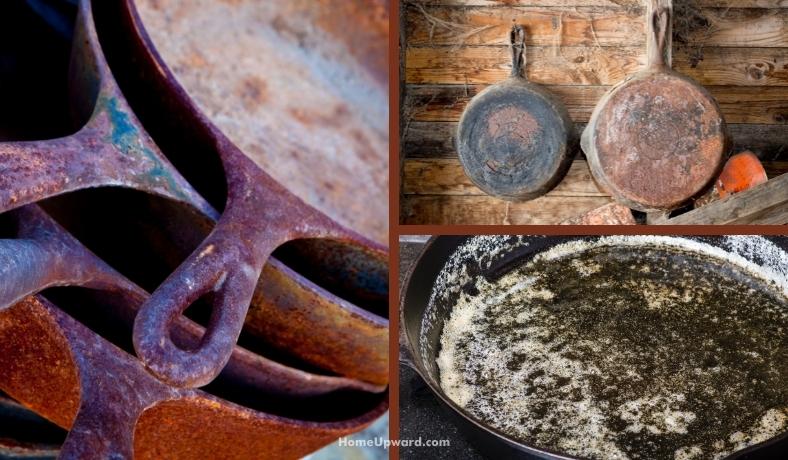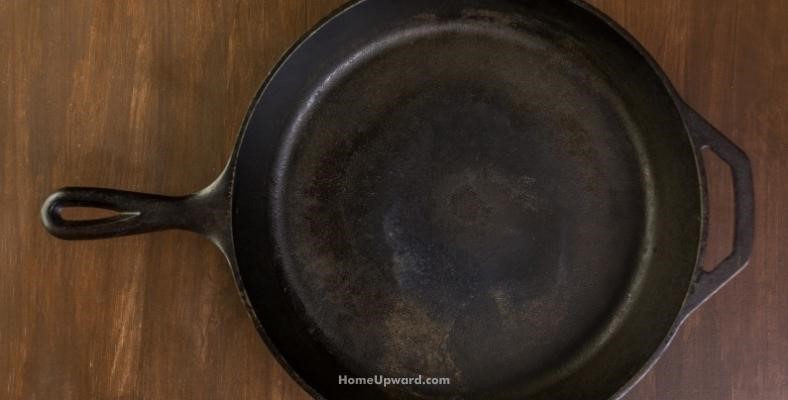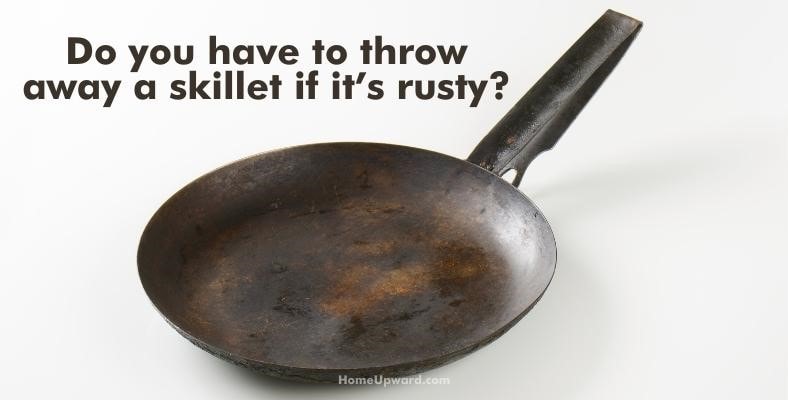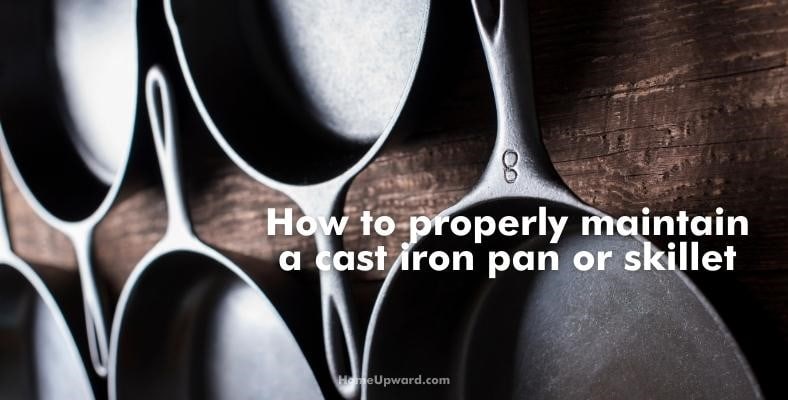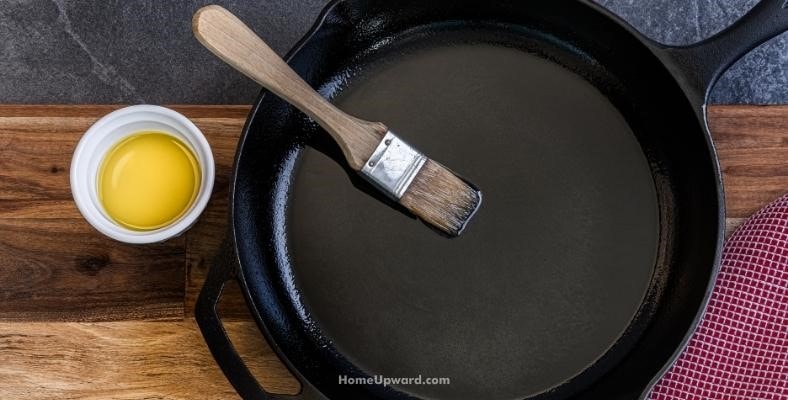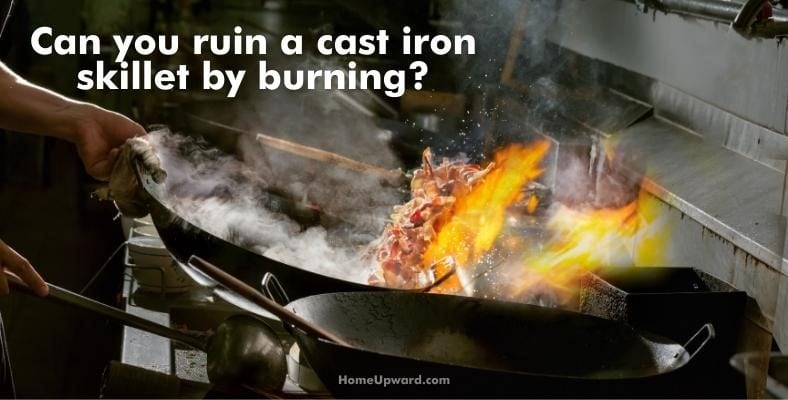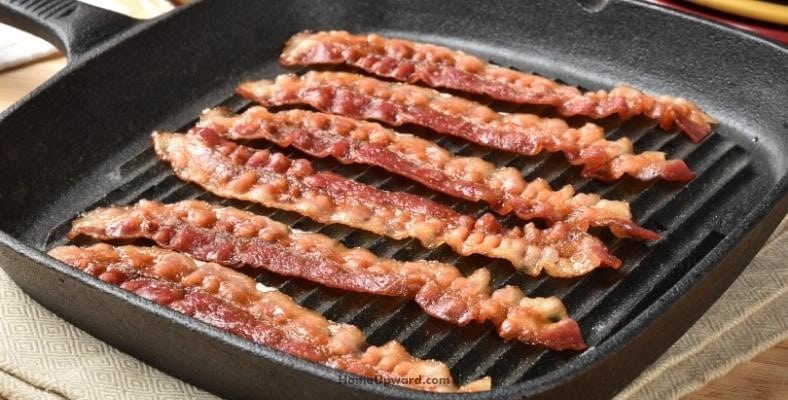Contents
- Reasons to Throw Away a Cast Iron Skillet or Cast Iron Pan
- Do you Have to Throw Away a Skillet if it’s Rusty?
- What is Bad for Cast Iron Cookware and Can Damage it?
- How to Properly Maintain a Cast Iron Pan or Skillet
- How to Season a Cast Iron Skillet or Pan Properly
- Can you Ruin a Cast Iron Skillet by Burning?
- Can you Leave Bacon Grease in a Cast Iron Skillet?
Reasons to Throw Away a Cast Iron Skillet or Cast Iron Pan
Unfortunately a truly damaged cast iron skillet can’t be fixed. Here are a few signs that your skillet is beyond repair.
Cracks or Holes
There is no safe or effective way to reseal this type of damage to cast iron cookware. A pan with cracks or holes in it should be discarded.
An Uneven Base
An uneven base means that the food will not cook evenly. You could technically still cook with it, but the result may not be safe to ingest, especially if your dish includes meat.
I would recommend discarding a pan with a warped base.
Do you Have to Throw Away a Skillet if it’s Rusty?
No! Follow this guide to refurbish a rusty skillet.
How to Clean Rust from Cast Iron Cookware
Minor rusting can be buffed off with sandpaper or steel wool. However, for more severe cases of rusting, you can try a vinegar soak to remove it. Here’s how:
- Combine equal parts white vinegar and water then submerge your rusty cast iron piece in the mixture. (The acid in the vinegar will dissolve the rust.)
- Leave your pan in the vinegar soak for about 8 hours at a time.
- Check on it frequently to avoid dissolving the iron itself.
- Once all of the rust has disintegrated, scrub it thoroughly with soap and hot water then dry it and reseason it.
Is it Okay to Use a Rusty Cast Iron Pan?
No! A rusty cast iron skillet can be dealt with but using rusty cookware is unsafe. Make sure your skillet is free of rust and dirt before cooking with it.
Rust is dangerous to ingest. If you cook with a rusty pan it could contaminate your food. Rust can also harbor dangerous bacteria and other pathogens.
If you see rust on your cookware remove it right away! It’s far better to not take a risk and to play it safe.
What is Bad for Cast Iron Cookware and Can Damage it?
Although cast iron pots and cookware are a vast improvement over other types of cookware you still need to take good care of them.
Not Enough Cooking Oil
This is a simple problem with a simple solution. Cooking oil is, among other things, a lubricant.
If your cast iron skillet isn’t properly oiled before you start cooking your food, the food will stick to the pan! This is usually true of nonstick pans and cookware, so it goes double for cast iron cookware.
The best way to avoid sticking is to make sure the surface of your skillet (or pot, or pan, or whatever!) is to generously and evenly coat it in cooking oil.
Heating it Without Anything In It
Heating your cast iron cookware without anything in it causes problems similar to those created by cooking without sufficient oil. When preheating the pan, make sure to place your cooking vegetable oil in right away.
If you add the room temperature oil when the pan is hot, it will splatter! This is dangerous for you and bad for your cookware.
With that said, wait to place the food in the pan until both the pan and the oil are hot. Heating cold food at the same time as the cast iron and oil will result in sticking.
Heating it Up too Quickly
Exposing your cast iron cookware to extreme temperatures too quickly is called thermal shock and it can seriously damage your pots and pan. Heating cast iron too quickly or unevenly can cause it to warp or crack.
Cast iron skillets are designed to tolerate high heat but they still have their limits. One common way cast iron can be heated too quickly is if it is placed directly over an open flame.
Cooling it too Fast When Hot
Much like heating a cast iron skillet too quickly, cooling a hot pan too quickly (for example, running a hot pan under cold water) can cause it to warp or crack.
The best way to avoid this is simple: just wait to clean your pan until it has reached room temperature.
No or Poor Maintenance
This almost goes without saying: if you don’t take proper care of your possessions, they will inevitably wear out, degrade, or break. This is as true of cast iron pans as it is of any other piece of cookware!
If you don’t carefully maintain your cast iron it could peel, chip, erode, rust, warp, or crack.
Don’t be nervous though! Check out the next section of this article for a complete cast iron cookware care guide.
Using a Dishwasher Instead of Hand Washing
Cast iron cookware should never be washed in the dishwasher.
The high heat, abrasive cleaners, and humidity in dishwashers will damage your cast iron cookware and degrade its patina. The only exception to this rule is enameled cast iron.
While enameled cast iron cookware is dishwasher safe, washing it by hand with dish soap and hot water is still recommended to preserve its exterior gloss.
How to Properly Maintain a Cast Iron Pan or Skillet
The trick to using cast iron in the kitchen is knowing how to maintain your cast iron cookware. Unlike nonstick cookware, cast iron can be quite finicky about its care and keeping.
Follow these steps to ensure your cast iron pans stay in tip-top shape!
Maintaining Cast Iron for Years of Trouble-free Use
Follow the next steps and tips to keep your cast iron cookware for ages and working.
1. Keep the cookware seasoned
After you’ve used and cleaned your pan, make sure to wipe a thin layer of oil across the base and inner walls of the skillet– essentially, everywhere you expect food to touch the pan.
This will keep your pan’s patina stronger for longer!
2. Use generous oil when cooking food
Using a generous amount of oil when cooking on cast iron will help to build your patina and protect your food from sticking to the pan.
3. Use plain water for cleaning
The patina on your cast iron skillet– much like the cast iron itself– is strong, but it is also brittle. Using anything other than plain water runs the risk of damaging your patina, which you need to keep your food from sticking to the pan.
Cleaning an Iron Skillet after Cooking for Good Maintenance
Keeping your cookware clean after using it is essential. This is true of every kitchen utensil, but it might be especially true for cast iron, which is prone to wear and tear if it isn’t cared for properly.
Here’s a step-by-step guide on how to clean any cast iron cookware:
1. Allow to cool down safely
Before attempting to clean your skillet, pot, or pan, make sure that it has cooled down completely. This is important both for your safety and for the overall health of your pan, as attempting to rinse it while it is still hot will cause it to warp.
2. Rinse with water to clean out excess oil or food particles
Use warm water or hot water to wash out whatever detritus is left behind in the pan. When cleaning cast iron, it’s important to avoid using soap or detergent to preserve the cookware’s patina.
Instead, you can use salt or baking soda to loosen any food particles, eliminate odors, and sanitize the pan.
3. Wipe down the pan or skillet with a damp cloth
Once your pan is completely clean, rinse it off and wipe it down with a cloth or paper towels. This will wipe away any remaining food debris.
Patting your cast iron cookware down with clean dry paper towels after this step will help to fight rust.
4. Allow to air dry fully
Once your pan is completely dry, lightly oil the inside, and store it somewhere dry and clean!
How to Season a Cast Iron Skillet or Pan Properly
Cooking is an art, and as such, it’s important to get our cast iron skillet or pan ready to get that delicious food we love!
Steps for Properly Seasoning Cast Iron Cookware
1. Heat an oven to 435-450 degrees
You want your oven to be hot enough to bake the oil onto your skillet, but not so hot that the oil burns. Don’t place the skillet in the oven until it has finished preheating!
2. Coat the skillet with lard or shortening
The best fat you can use to season your cast iron pan is a matter of opinion. Each one comes with its pros and cons. I would recommend a neutral-tasting oil with a high smoke point, such as avocado oil or rapeseed oil.
A smoke point is a temperature at which an oil begins to produce smoke. Flaxseed oil is a popular choice for the strength of the patina it creates but the low smoke point makes it a little bit difficult to use.
You can also use other fats, such as butter, shortening, or lard.
3. Bake the skillet for a few hours
This is the easy part (or, if you’re impatient, the hard part). The process of baking the fat onto your cast iron pan is called polymerization.
When this process is complete, your skillet will have a dark, shiny finish evenly covering it. To get this it may be necessary to give your pan a second coating of oil and bake it again.
How Long Does Seasoning Last on Cast Iron Cookware?
If you regularly use and properly maintain your cast iron cookware its polymerized coating can last for years.
How Often Should you Season a Cast Iron Pan or Skillet?
Most experts recommend that cast iron cookware should be oiled after each use. This is part of your cast iron’s regular maintenance.
However, the more in-depth process of oiling and baking your cookware can be much less frequent. Depending on how frequently you use a particular piece, you will only need to re-season it 2-3 times a year.
You will be able to tell that your pan needs to be reseasoned when it no longer displays the dark, shiny semi-gloss finish typical of well-seasoned cast iron.
The more you use it, the more you’ll oil it, and the more you oil it, the healthier its patina will be!
Can you Ruin a Cast Iron Skillet by Burning?
Having burnt gunk stuck to your cherished cast iron skillet can be aggravating, but is it bad for your cookware’s long-term health? You can certainly damage your cast iron cookware by burning it, but– barring extreme cases– this damage is usually reversible.
Read on for a guide to cleaning your burnt cast iron cookware safely and effectively!
How to Get Black Residue or Burnt on Grease Off a Cast Iron Skillet
Do not use soap to clean burnt residue off your cast iron skillet. This will ruin the patina you’ve built up by using and maintaining it.
You should also avoid abrasive cleaners and tools like steel wool, detergent scrubs, and scouring pads. Here’s what you need to do:
- Sprinkle coarse sea salt, kosher salt, or baking soda into the pan with hot water.
- Scour your cast iron frying pan with a paper towel, clean sponge, or washcloth.
You can also purchase special chainmail pads and bamboo cleaning whisks made specifically for cast iron cookware if you so desire. Once the skillet is clean, pat it completely dry with paper towels.
This will help to prevent rusting in the future.
Can you Leave Bacon Grease in a Cast Iron Skillet?
It’s best to avoid leaving anything floating around in your cast iron cookware.
Leaving used fat such as grease, oil, or shortening in your pan for an extended period will cause it to go rancid and house unsafe bacteria. If this happens, you may need to throw your cookware away.
If you want to reuse old cooking oil, make sure it’s an oil with a high smoke point like avocado oil, rice bran oil, soybean oil, safflower oil, or sunflower oil. Bacon grease isn’t good for this as it has a fairly low smoke point of 375 degrees Fahrenheit.
Reusing cooking oil after skillet cooking
To reuse cooking oil:
- Wait until the oil and your cookware cool down completely.
- Next, strain out any detritus (particles) left over from your last fry.
- Pour out and store the oil at room temperature in an airtight container like a glass jar or a Tupperware container.
This oil should remain usable for up to 4 months. Once you’ve cleaned up and stored the remaining oil, clean and dry your cast iron cookware as you normally would. You’ll be ready to go for cooking next time and save money on cooking oil!

